The idea of visiting a place that you always wanted to go to is the most exciting of all. I live roughly about 30 km from the Arunachal Pradesh state border. However, I didn’t have the opportunity to explore beautiful Arunachal Pradesh until October 2019.
I was so excited that I helped Timeless Existence (Our trek organiser) with all the formalities (like issuing ILP – Inner Line Permit offline) and communicating with other hikers to make it possible. I wanted this trip to happen no matter what.
The Monpa Trail Trek
As the name suggests, the trek passes through the stunning landscapes and hills of the Monpa ethnic group in Dirang of West Kameng District, Arunachal Pradesh.
The trek starts from Sangti Valley in Dirang of West Kameng District of Arunachal Pradesh. It then crosses through Khalibok Village, Chander, Pangma and ends at Thembang Village.
The Thembang Fortified Village is a UNESCO world heritage site. Its rich culture and existence can be traced back to Neolithic times.
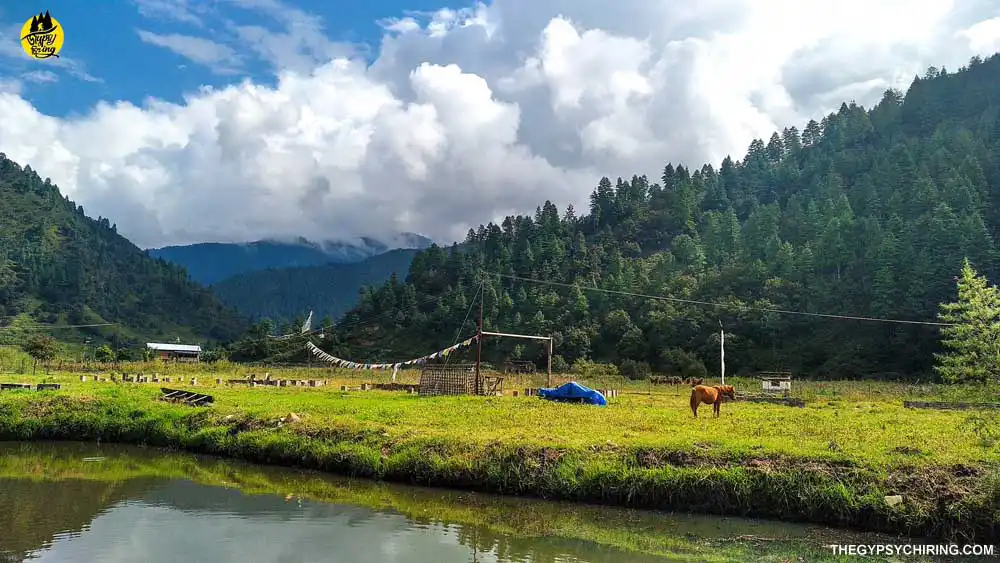
The Monpa Trail Trek is a wonderful combination of cultural interaction and scenic trekking experience. Let’s dive in on how our 4 days of adventure unfolded.
DAY 1 – The Avatar Hills & the never-ending journey (Guwahati, Assam- Dirang, Arunachal Pradesh)
We set out to Arunachal Pradesh via Guwahati-Baihata Chariali-Mangaldai-Udalguri-Bhairabkunda-Balemu- Shergaon-Rupa-Bomdilla-Dirang route.
After Crossing Bhairabkunda, the drive gets better. On one side of the river is the Balemu Road of Arunachal and on the other are the hills of Bhutan. The entrance to Arunachal was unique, the weather turned a little gloomy, with cloudy hills and sun rays passing through it.
The drive initially passes alongside the River. As we drove ahead and higher, the scenery was such that if paradise exists then it must look like this. The long stretch of forests, colourful trees, and flowers by the river felt like a wonderland.
The higher we went, the more unique the scenery was. At one time, we felt like we were in the movie of Avatar – the car was our dragon and the hills around us were the floating hills. We could see only the upper part of the hills and gorges – steeper ones.
After crossing Balemu, Shergaon and Rupa are two beautiful destinations before Bomdilla. The journey seemed longer and longer with the distances on the signboard hardly decreasing any.
Doesn’t it feel amazing when you read about a place in an old book or a novel and you eventually visit the area? I read about Bomdilla in the Assamese Novel “Moun Uth Mukhor Hridoy”. I could relate to the depiction of the place in the book. We reached Bomdilla by sunset.
A journey that started around 8 in the morning concluded when we reached the Sangti Valley in Dirang. Sangti Valley Campsite is located a little ahead of Dirang town. We crossed a small hanging bridge to reach the Letro Homestay & Campsite located by the river.
The soothing river sounds, songs around the bonfire and some funny conversations with friends & other campers faded our tiredness in no time. It was a soothing good night’s sleep with the music of the river. Sleeping with the sound of the river was a lullaby to me.
Monpa Trail Day 2 – Khalibok to Chander
Awestruck! As soon as I unchained the tent, the clouds emerging from the hills- the top with clouds, with the pine trees was a thrilling experience.
The previous day we had reached the Sangti Valley Camp by sundown and we were able to enjoy only the night ambience.
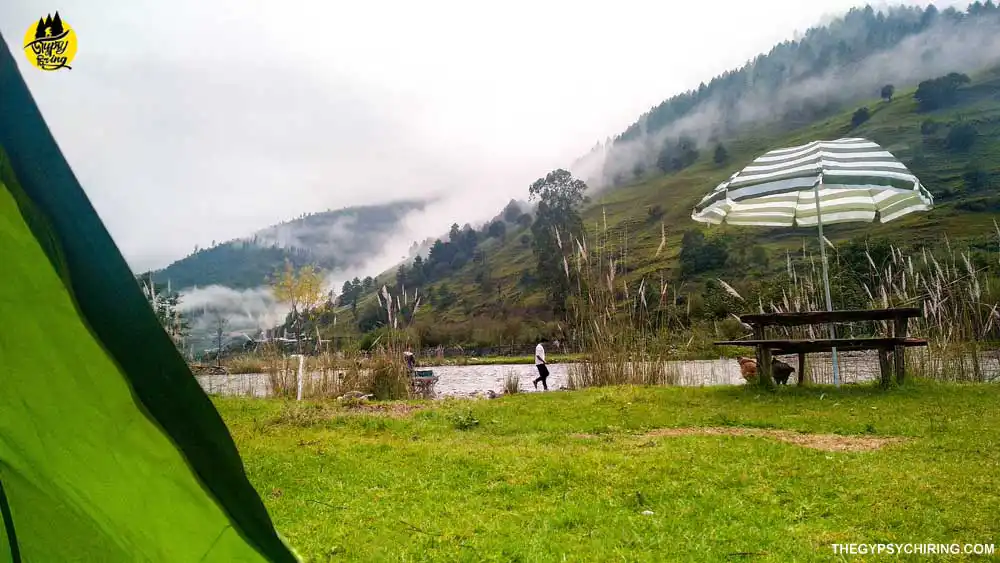
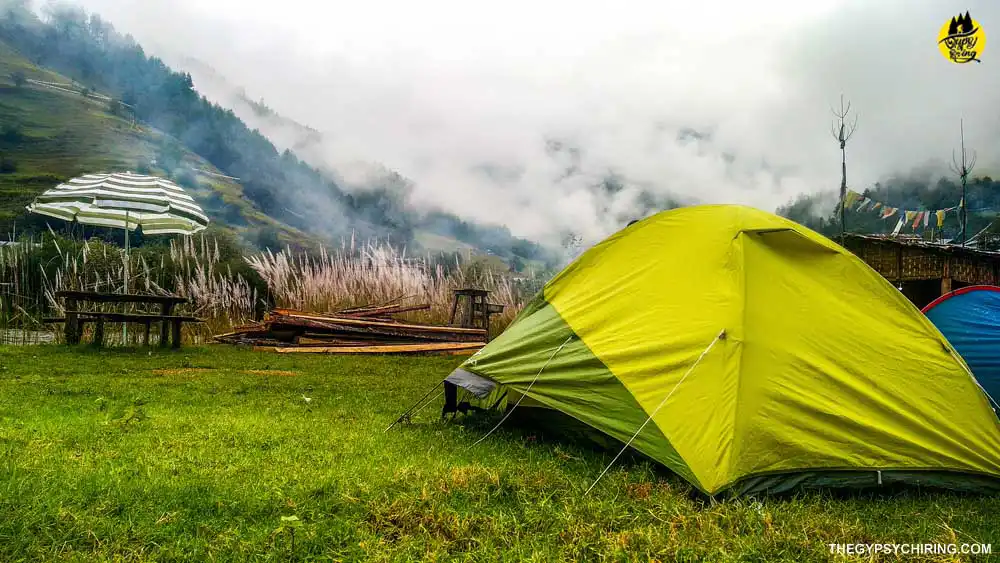
Dipping our feet into the cold waters of the river, we enjoyed the view of the pine-filled cloudy hills. Meanwhile, our fellow female trekkers took a stroll in the village and interacted with the locals.
In Sukmaya Lama’s words,
“I woke up early and went for a stroll in the village nearby. It was quiet at the campsite but the villagers were up early. Norbu Ma’me was generous to provide us with tea and cheura. I thanked her for the trust and love with which she made us feel at home. Such small moments take away a part of my soul and I have no regrets to leave it behind.”
Read Sukmaya’s write-up on the Monpa Trail Trek published in The Assam Tribune.
As we saw our guide Ngwang and other porters arriving at the hanging bridge, I rushed to pack my bags to be ready for the trek.
With a healthy bread and omelette, we headed for the highest hill we could see from Sangti Valley i.e. Chandar (pronounced Chander).
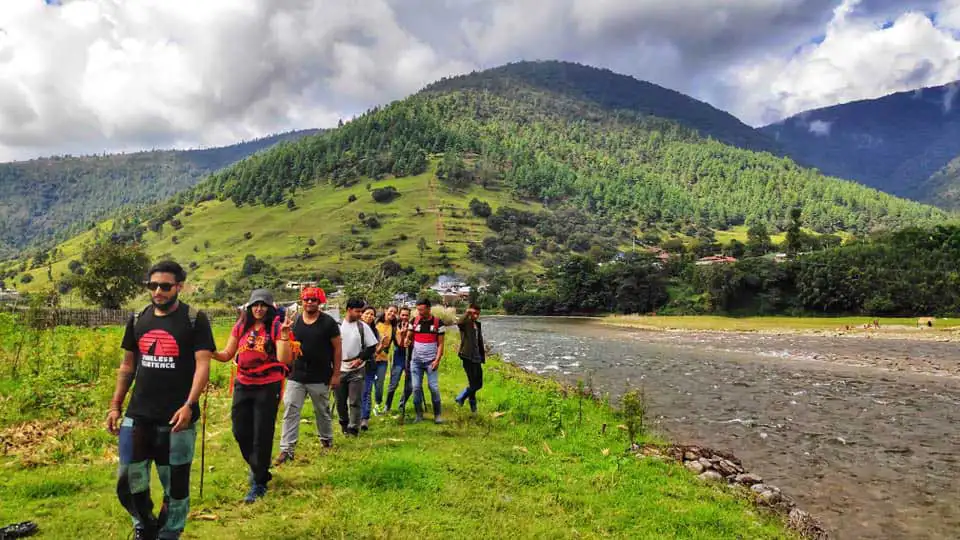
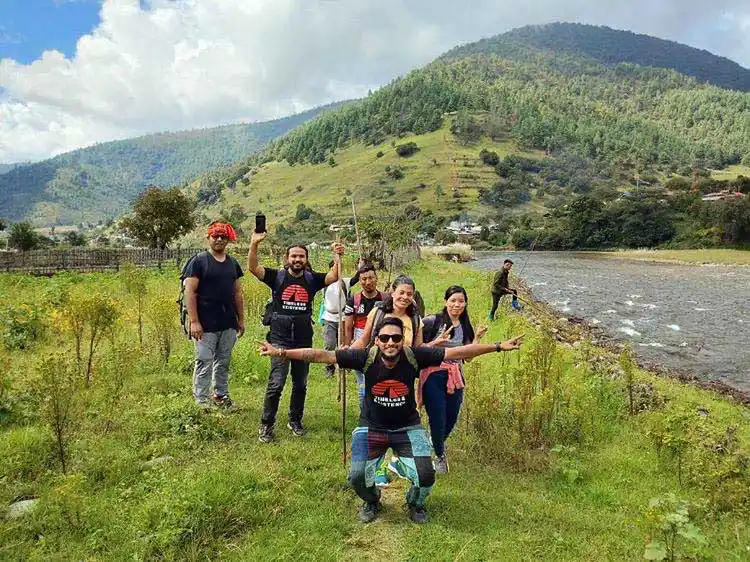
We started our trek by the Sangti River enjoying the bright sunny day, blue skies and green hills. As we climbed a little higher, the scenic view of a distant monastery, the hills and the river amplified.
Colourful butterflies, tiny streams and life goals formed my conversations with Sukmaya while trekking – moments I will always cherish.
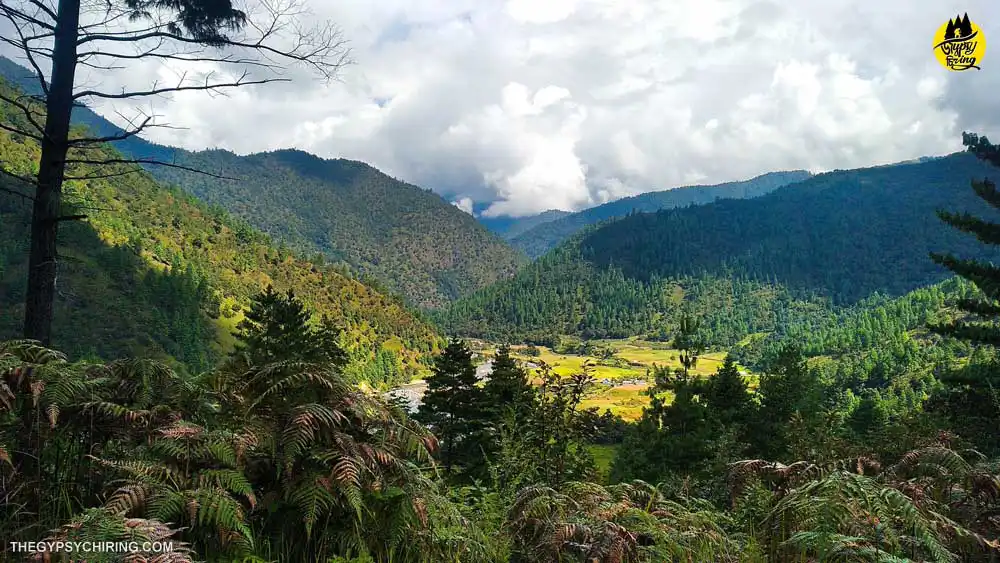
Among our jolly guides, one was from Darjeeling – Devanand, the others from Sangti. Our lead guide, Ngwang Achi was the coolest of all. He shared his knowledge about the place and their Monpa culture and uplifted our moods with his humour.
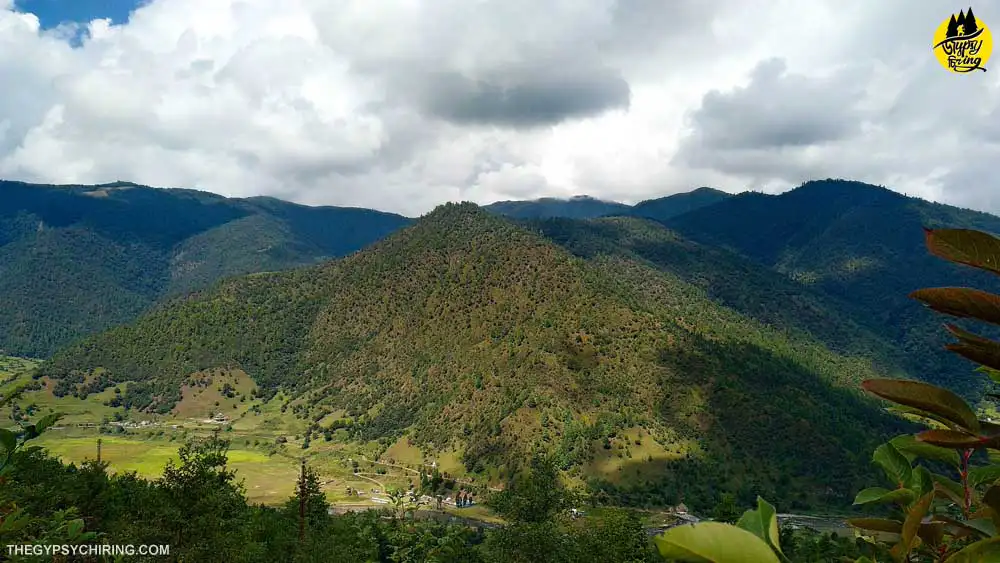
Hiking a little higher, we neared Khalibok Village. The terrace fields shone in hues of yellow and shades of lemon green. It was fascinating to see the clouds covering up the entire stretch of Sangti Valley on the other side.
A little later, the clouds roared with thunder and the rain poured heavily below at the Sangti Valley. Never in my life had I ever seen the rain pouring from a height that is below me.
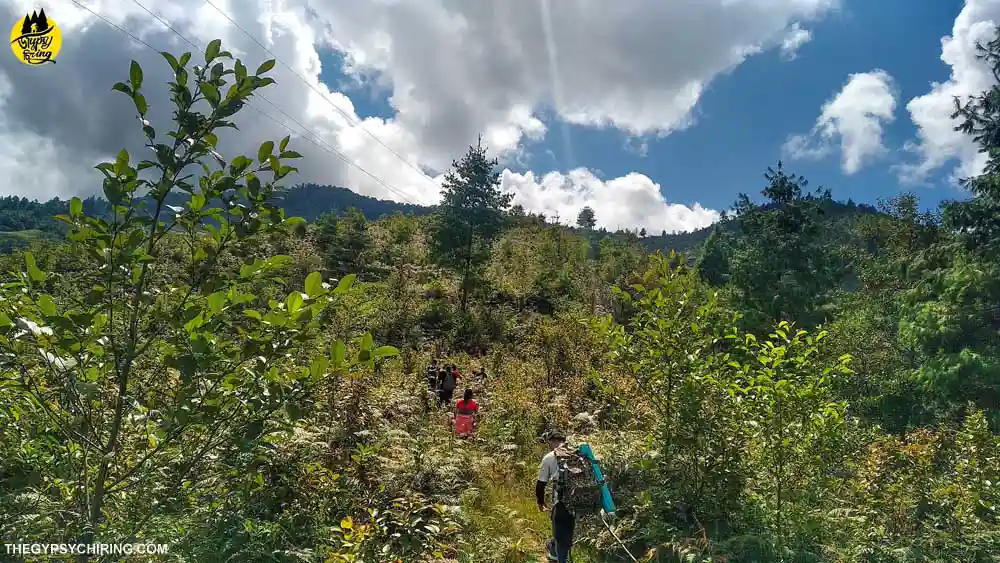
We greeted the local folks who were going down to the valley. Though most of the climb was through a narrow trail, as we neared the village, there was semi-gravelled and then a muddy road that led to the village from a different route.
We met more people who were visiting Khalibok Village – all dressed up and with a lot of groceries, cold drinks and eatables. We wondered if there might be some festivity in the village. I remember a local Monpa Uncle gifted us a cold Drink- It was Fanta!!
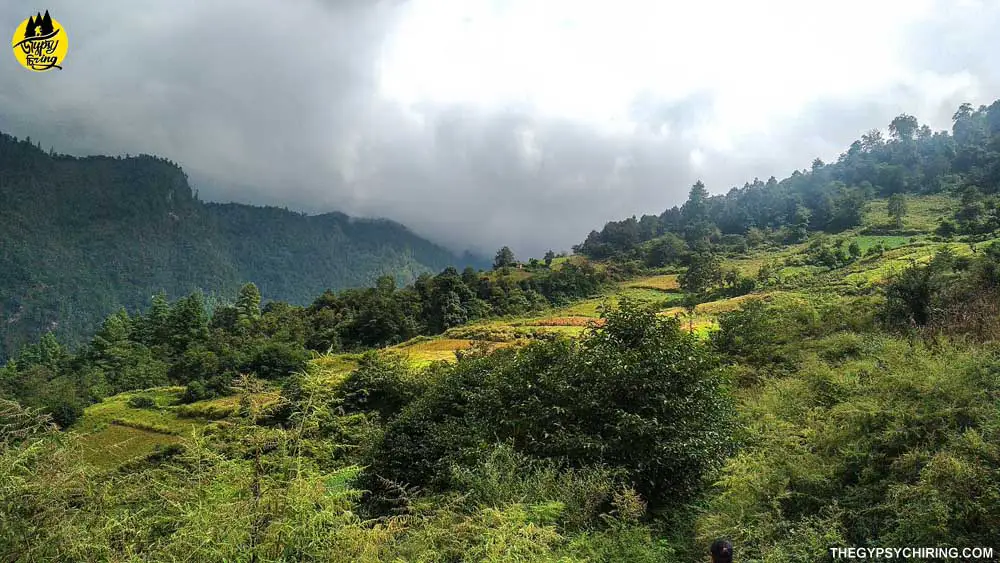
Climbing a few more muddy trails, and concrete steps, crossing a stupa, greeting the local folks and huge cabbage fields, we reached the Khalibok Village.
A two-storey house made of rocks and wood facing the valley and the bright yellow corn drying shed – was Ngwang Achi‘s (brother in Monpa language) house.
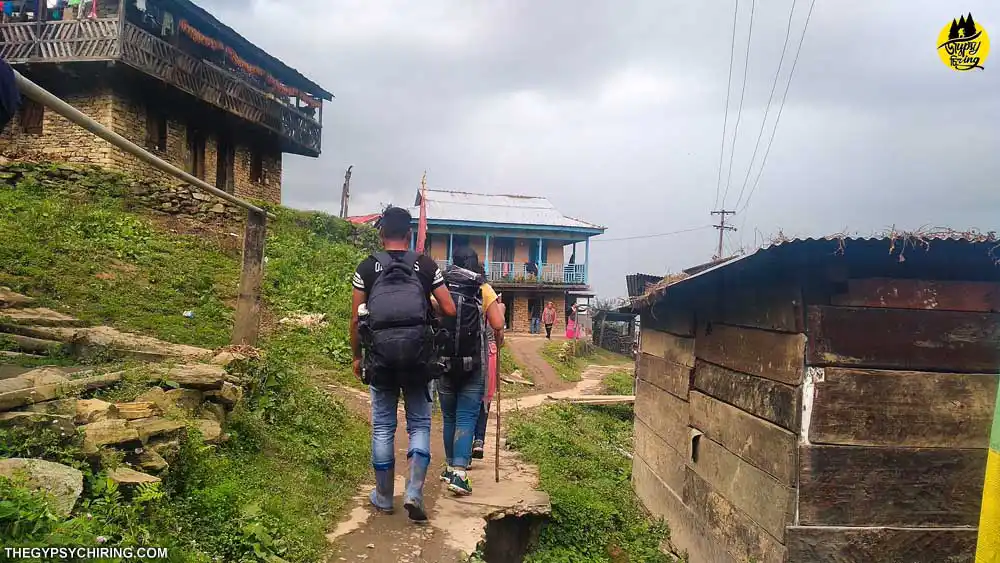
The initial idea was to take the lunch break at Khalibok Village. As we rested and had our lunch, the rain that poured down the valley eventually came up and bathed the entire village.
Considering the rain, our trek organiser Timeless Existence decided to stay at Khalibok Village for the night and trek to Chander the next day.
The decision to halt at Khalibok turned out to be the best. The rain ceased and the view thereafter was magical. The clouds in groups would lay over the hills below like a white blanket of love partially covering the hills.
With every minute, the scenery would change and the peaks beyond revealed themselves. The yellow corn shed against the view of the play of clouds with the hills perfectly matched with each other.
Kavya and I took a walk and explored Khalibok Village. We found corn dried in every household. The villagers dried red chillies forming a layer on the tin roof. It added an element to the beautiful village landscape.
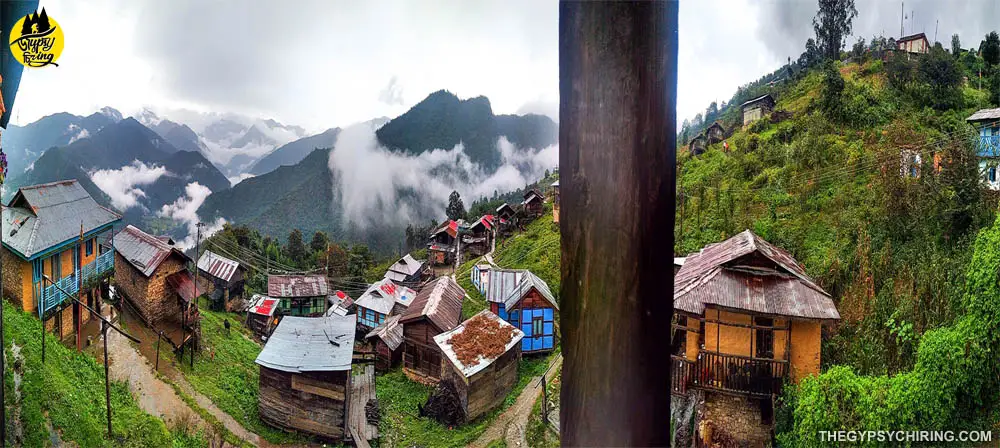
It was then I figured out that the village headman (jibi) passed away a week ago. The guests we met on our way were here for the rituals at the Village Gompa.
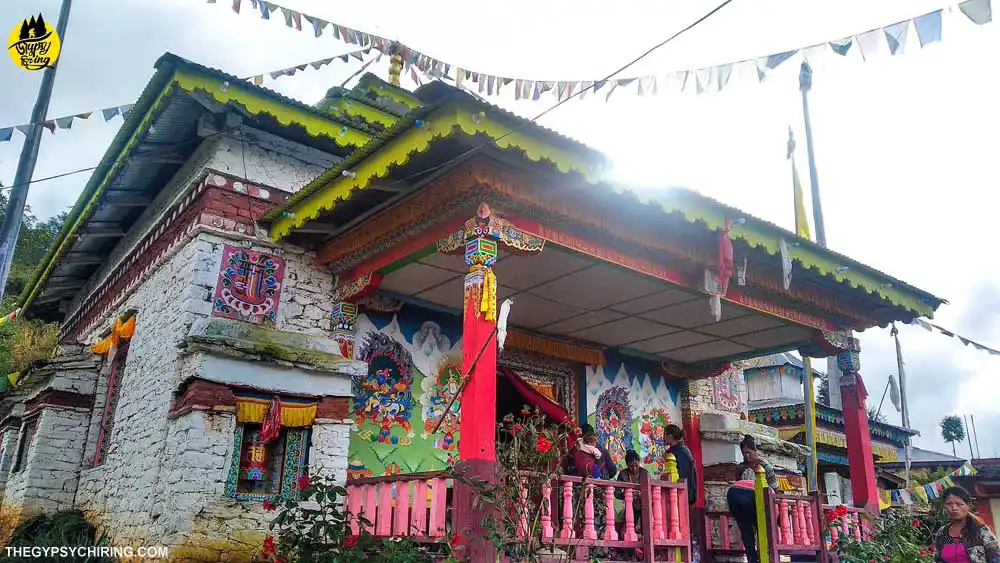
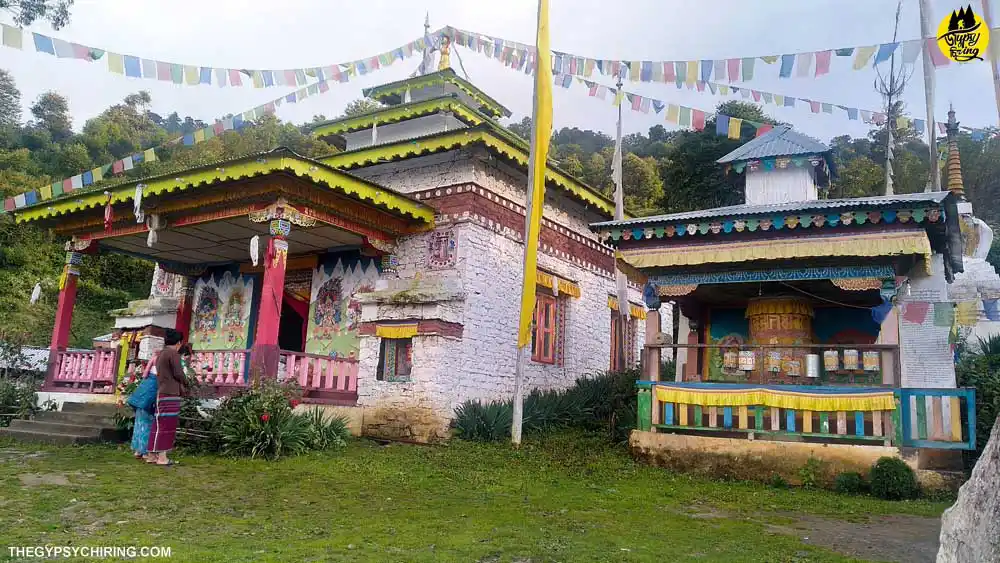
The people of Khalibok village invited us to attend the rituals at the Gompa. They offered us “tormu” as prasad, while we offered our prayers.
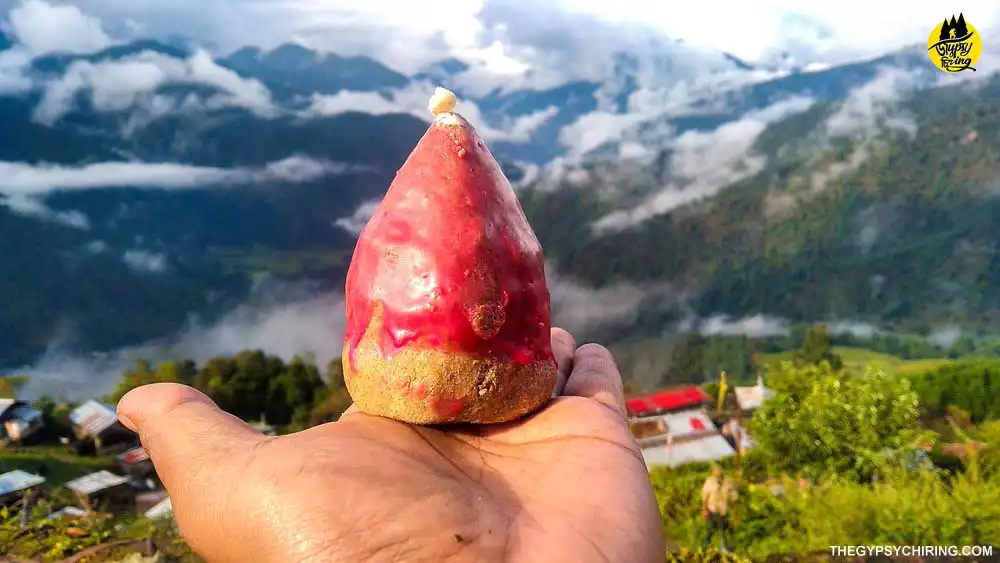
The viewpoint from the Gompa is the best of all – a panoramic view of the village, the valley and the hills on the horizon.
What I love about clouds is their joyful flight. It flew around the valley, then covered the hills and villages and came above to greet us.
According to the locals, Mt. Gorichen can be seen in clear weather.

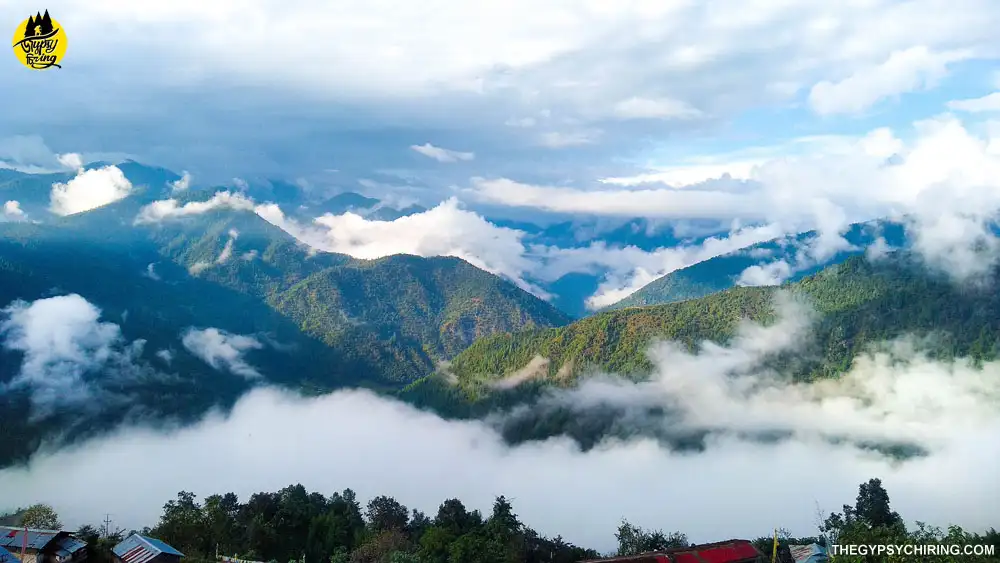
Have you tried a local drink during your travels? At Khalibok, we were introduced to Baang-chang and Aaarak. Baang-chang is a local drink generally derived from rice but it can also be made by mixing millet, maize and barley.
Aaarah on the other hand is prepared by distilling millets, maize and barley. Aaarah is the stronger version and is served hot in a small cup. A cloudy evening and some traditional brew, perfect evening right?
Traditional dinner with Ngwang Achi’s family was a pure delight. By the Gompa, in a small gathering room, we laid our mats and rested our backpacks.
We were blessed to be in the same spot where we witnessed the magical scenery during the day. We enjoyed the cold breeze that blew under the starry sky for a while and slept.
Monpa Trail Day 3 – Khalibok to Chander – Better Views and Leeches.
A rather Busy morning constituted the search for a washroom and the episode of Kavya’s injury from a fall. We bid adieu to Ngwang Achi’s family and started our uphill trek to Chander – the topmost settlement point in that area.
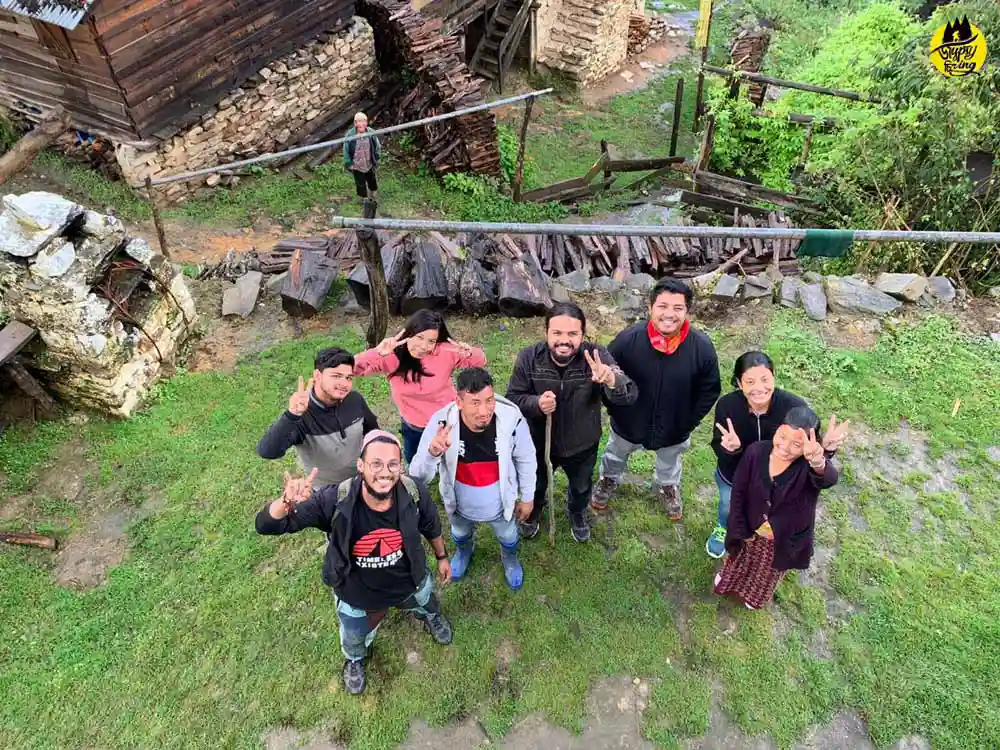
The people of Khalibok suggested starting early as if it rains there would be more leeches on the trail. Luckily, the sun was shining bright lightening up the hills.
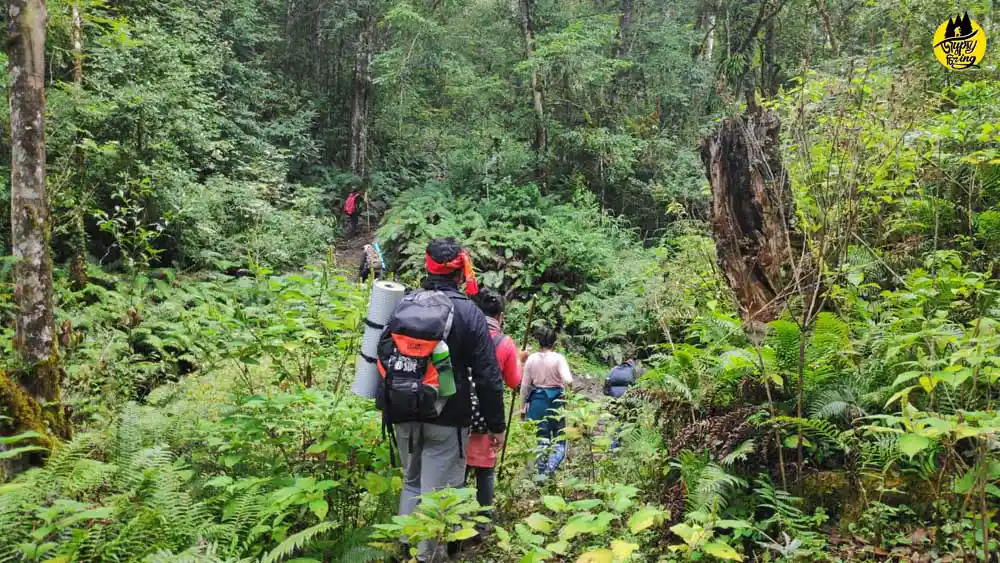
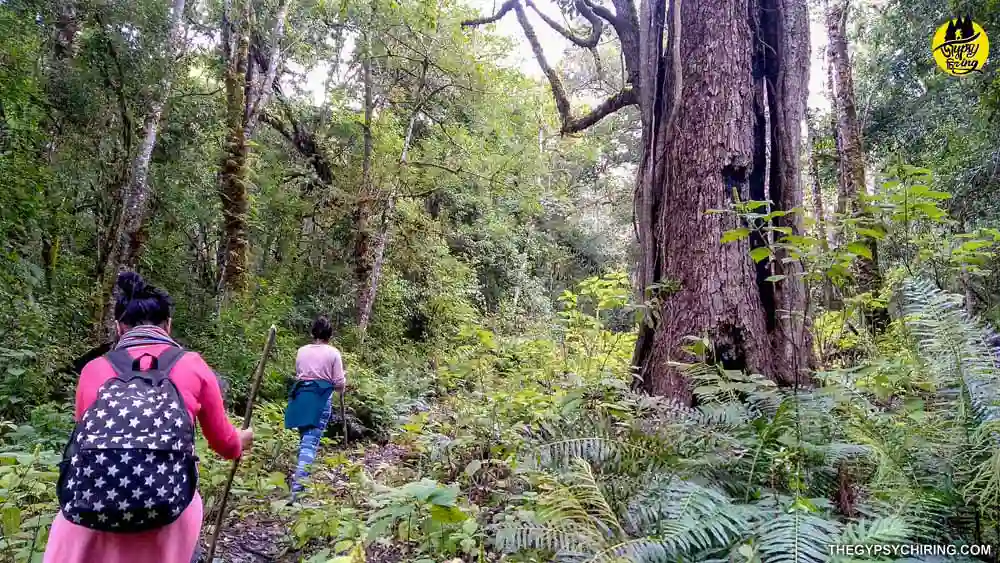
The trail from Khalibok to Chander passes through dense forest areas that involve fern-filled slopes at times and then dodging off under the fallen tree logs. Leeches indeed greeted us but not that much, haha!
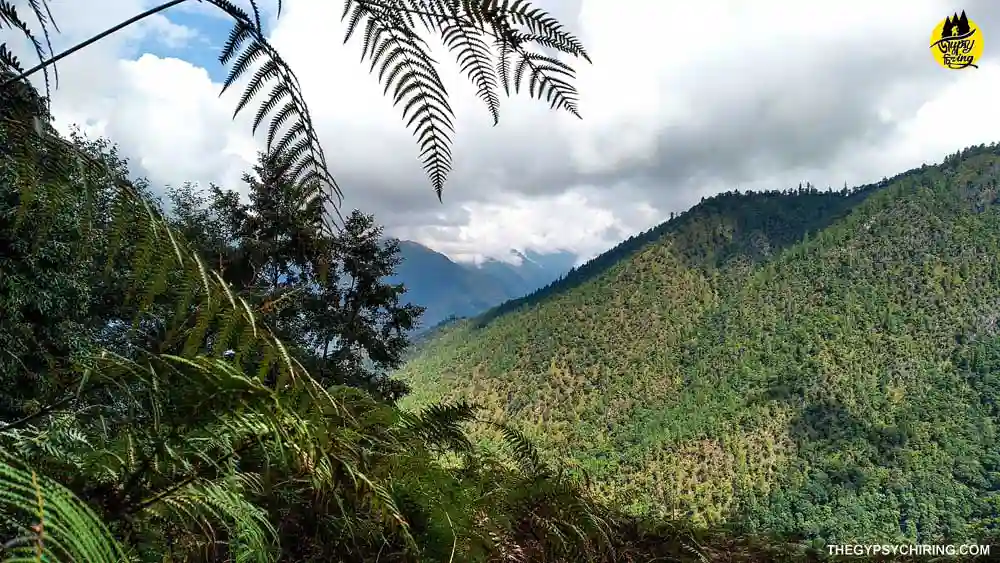
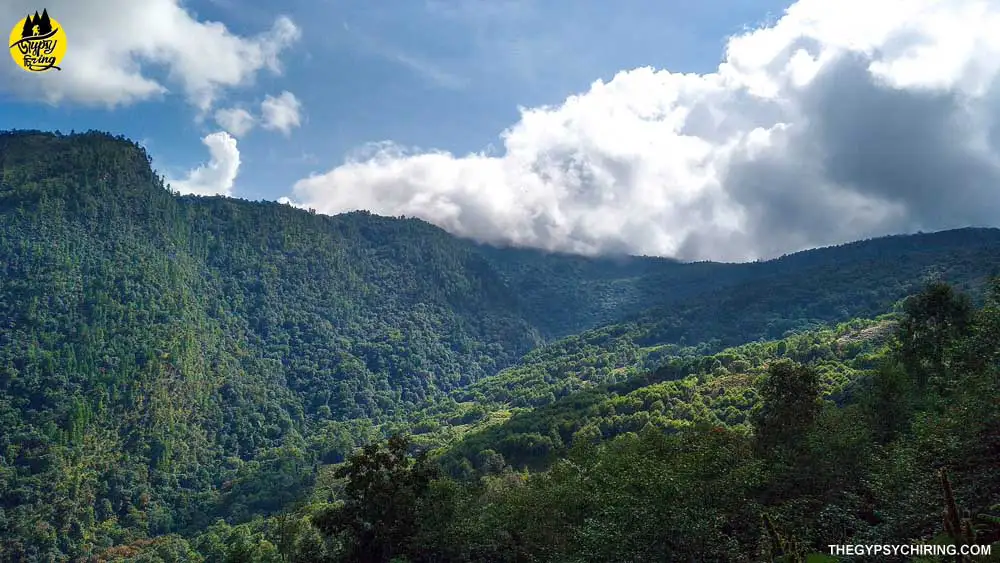
As we neared Chandar, we saw yaks and horses grazing in pasture land amidst the forest. I was excited to see the view of Sangti Valley from the Top of Chander and Mt. Gorichen Massif, if lucky. The weather however turned foggy and covered the trail end including Chander.
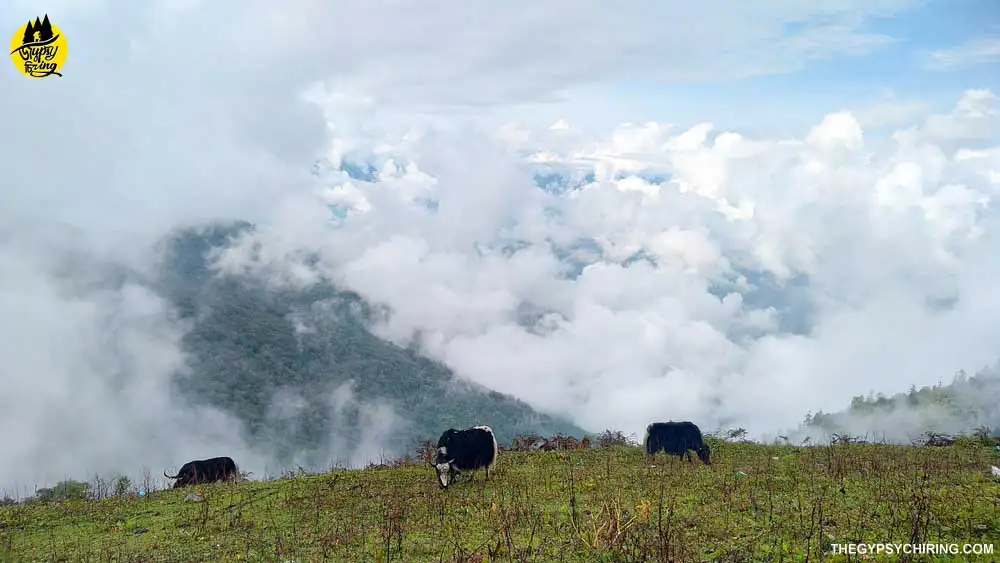
Standing atop a rock and facing the valley, I exclaimed, “Welcome to Chander!”. Though the view towards the valley faded, the opposite side of the road was as scenic as it could be. We marched towards the village. Yak bells, misty roads and cloud-covered houses- Chander it was!
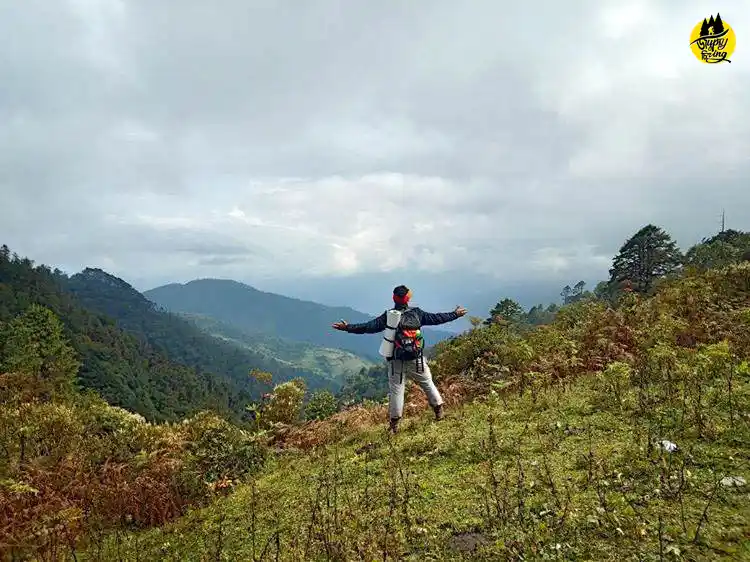
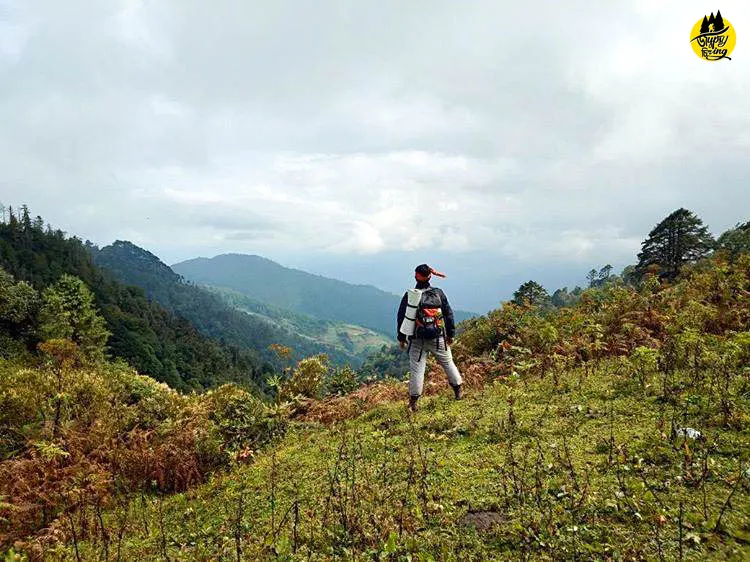
Chander is a small hamlet with about 12-14 households. The Monpas of Chander are yak herders. Their main source of income is from manually made cheese and yak butter.
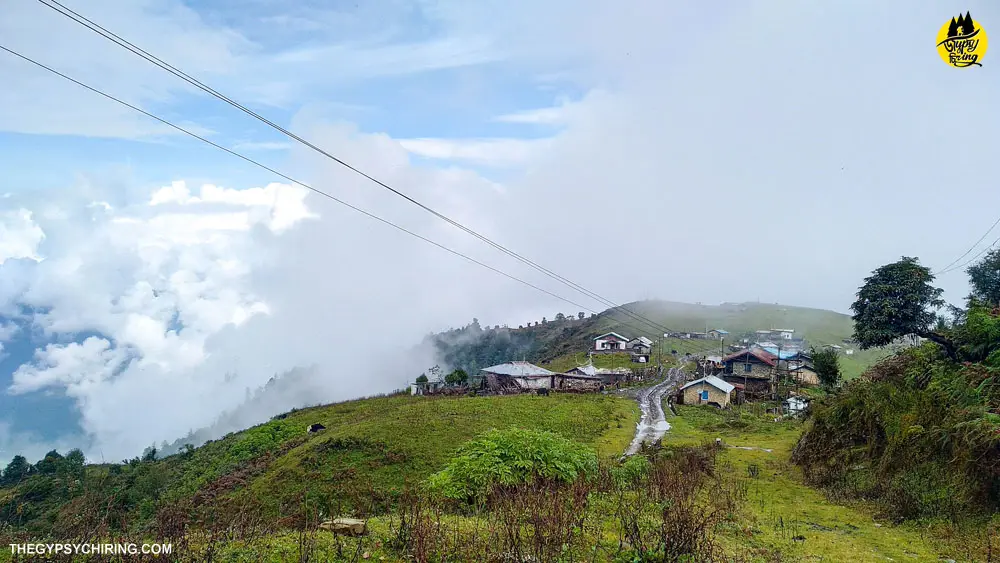
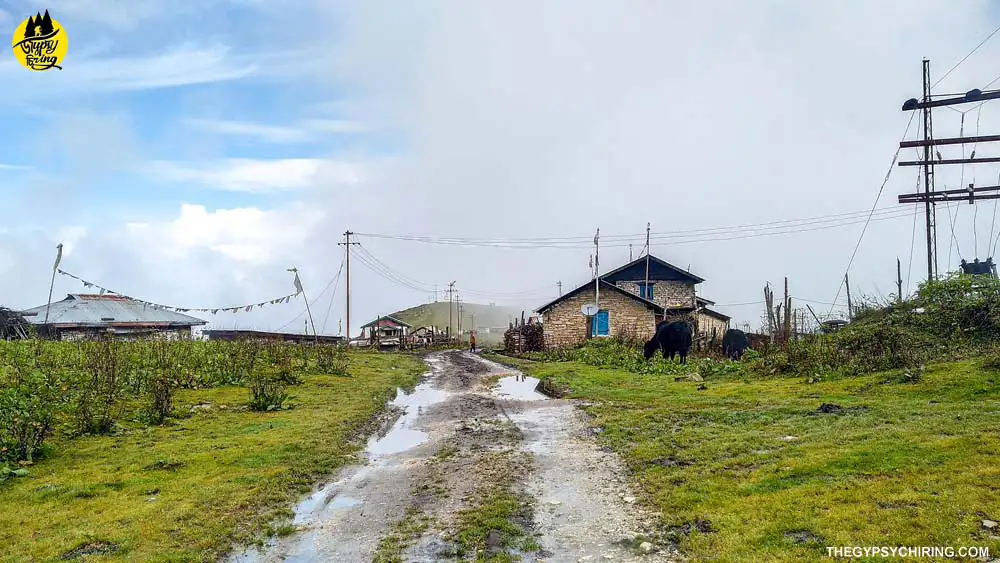

At Chander, our stay was organised at Ngwang’s Sister’s house. While our lunch was being prepared, Ngawang gave us a village tour. We walked through the muddy roads greeting the locals. Barely visible roads covered with fog, we could only hear the bells of yaks.
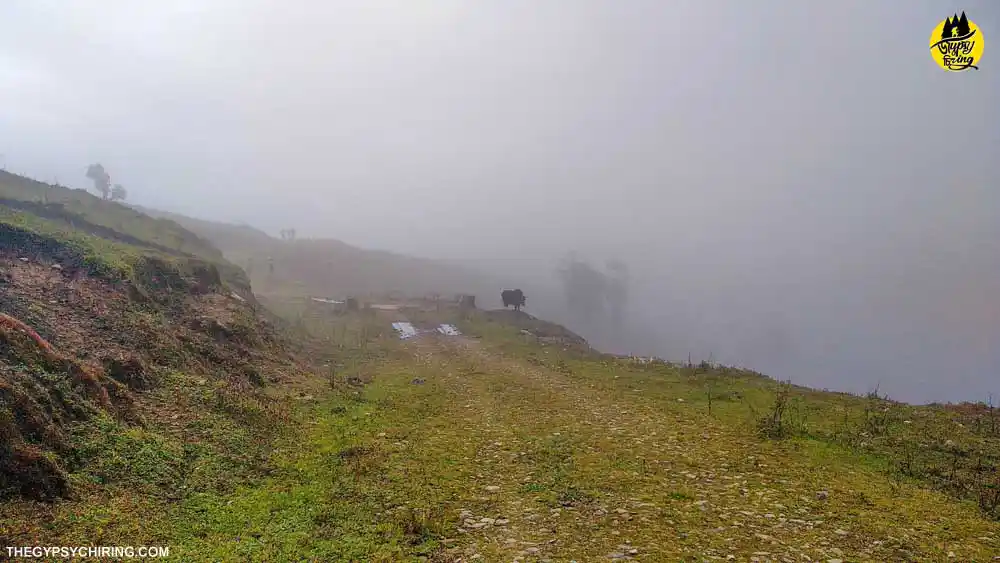
After a 10-15 minute walk, we reached a Yak Breeding Farm. The farm looked like an abandoned fenced compound with a few wooden huts. Perhaps it was the clouds that added a more gloomy ambience.
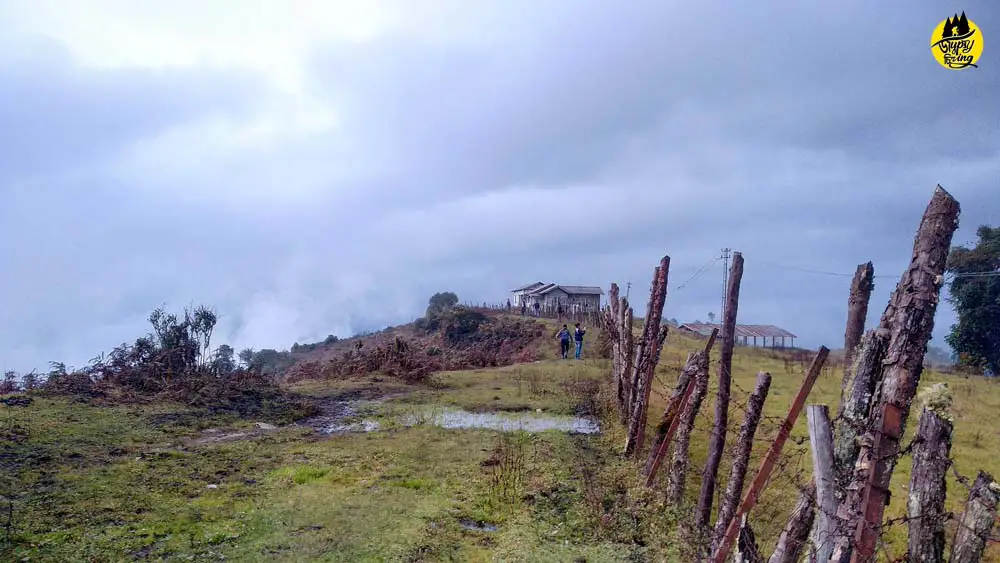
The view of the valley from the farm became relatively clearer than before. While the beautiful scenery satisfied our souls, our stomachs craved food. We rushed back to our place of stay.
When the clouds faded a little, the landscape of yaks grazing on a slope against the background of cumulonimbus clouds was surreal. One can distinctly see Mt. Gorichen Massif from Chander during clearer weather.
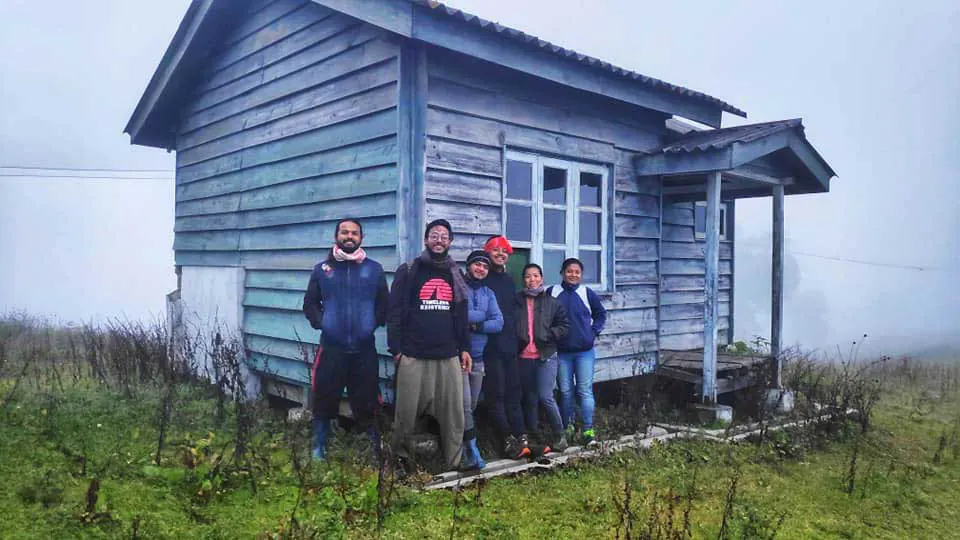
Unique places, unique experiences! At Chander, I volunteered to help Ngawang’s Sister in fixing their dish antenna. As I rotated the antenna and waited for the signal update from their house, a chilly wind blew every few seconds.
Though I loved the fog around me, the wind grew stronger and was unbearable. Alas! I eventually gave up.
The coldness grew colder by evening. All of us gathered around the fire in the kitchen. The fireplace was unique – boxed shaped and a piped chimney attached to it. The best conversations happen around the fire, don’t you agree?
They shared about their life in Chander, the hardships, their life and the yaks. Didi’s son performed a hip-hop dance for us too. Tea was followed by local drinks like Baangchang and Aaarah.
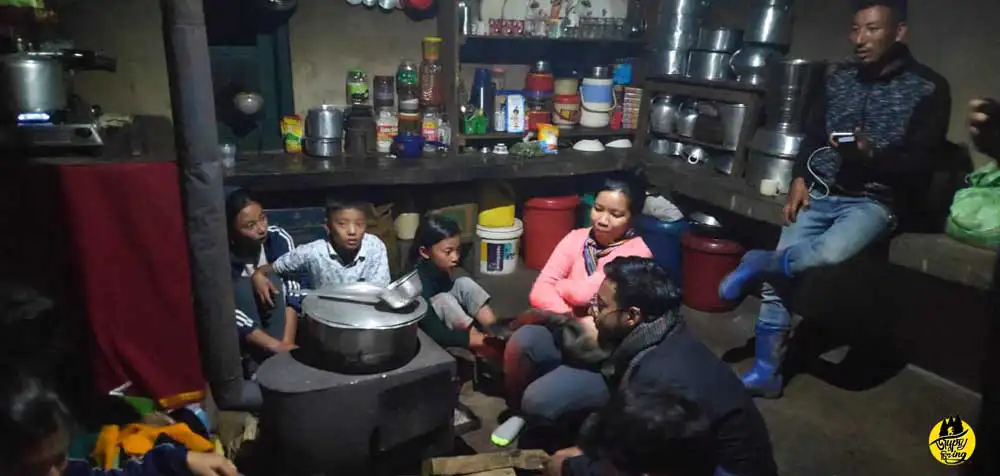
I joined Ngawang in singing and dancing to one of their Monpa Songs. Culture has always fascinated me, I enjoyed matching his Monpa dance steps as much as I enjoy performing Bihu Dance.
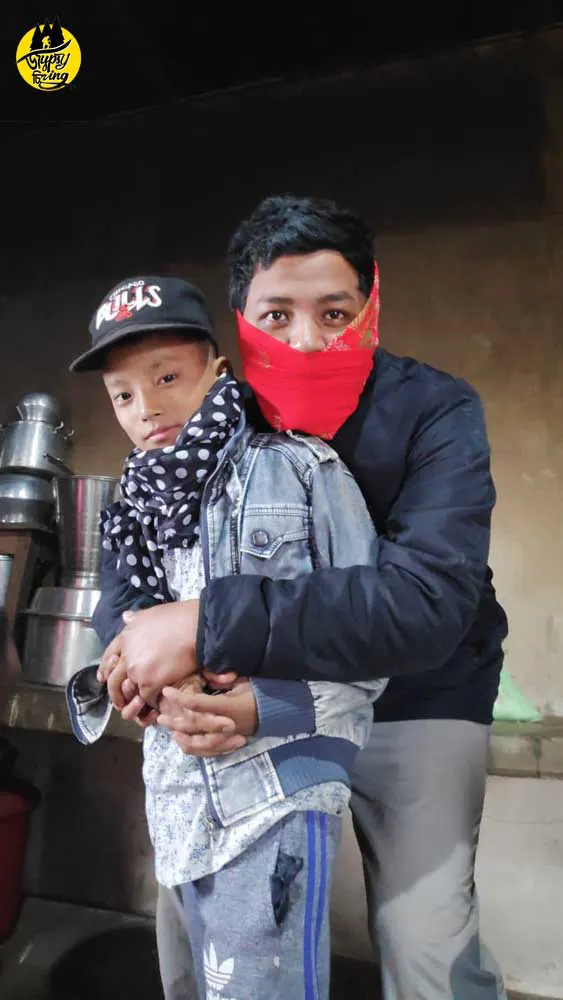
It snows at Chander in Winter. The winter hadn’t arrived but I could swear it was colder that night. The eventful day ended after we pitched our tents in one of their empty rooms.
Monpa Trail Day 4 – Chander – Pangma & Thembang (Arunachal Pradesh) to Guwahati, Assam.
Struggling with the coldness in the morning, I woke up. It was time to bid farewell to the host family and Chander.
Marching through the dense fog, we started our hike downhill to Pangma Village. The density of the fog was such that it confused our guide about the trail.
While Ngwang searched for the network connectivity to consult with someone, we gathered at a spot surrounded by unique and colourful ferns, shrubs, trees and flowers. It felt like a blessing.
As we walked ahead, huge leeches from the ferns and other flora would stick to our dresses now and then. We would stop once in a while to make them go away.
This hike from Chander to Pangma was the most magical ever – courtesy of the fog. We crossed streams and log bridges; traversed through rocky edges and even slipped in those muddy trails surrounded by bamboo shrubs.
The continuous descent led us to a plain land amidst the hill where small streams flowed, birds chirped, and the fog turned into drizzle.
The entire ambience was magical – the euphony of birds, the streams and the splash with every step. The ambience was such that I hardly took any pictures to capture them – for I was enjoying it.
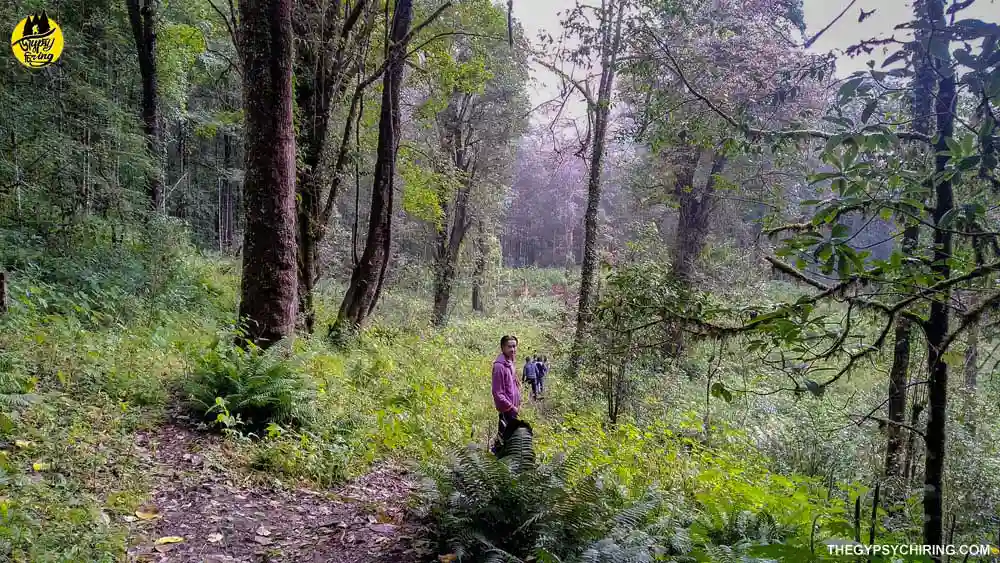
We reached Pangma by the afternoon. The real struggle then was to hunt the hidden leeches in our socks and shoes, haha!

A warm soup followed by lunch uplifted our moods. Like Khalibok, the play of the clouds with the hills after rain at Pangma too was beautiful. Pangma is a small village with about 14-15 families. We set up our tents in an abandoned school hut. Ngwang then introduced us to the place with a village tour. The Chinese once invaded Arunachal and reached Tezpur in Assam crossing this village.
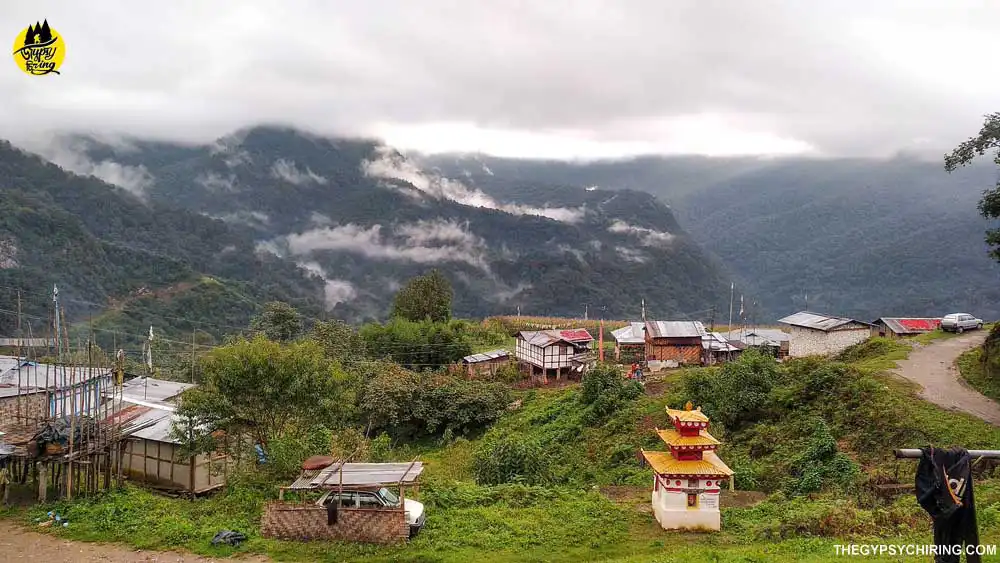
Ready to harvest cornfields in the backdrop of cloudy hills, horses and the sight of a few incomplete house buildings could be seen as we walked down the trail to the village.
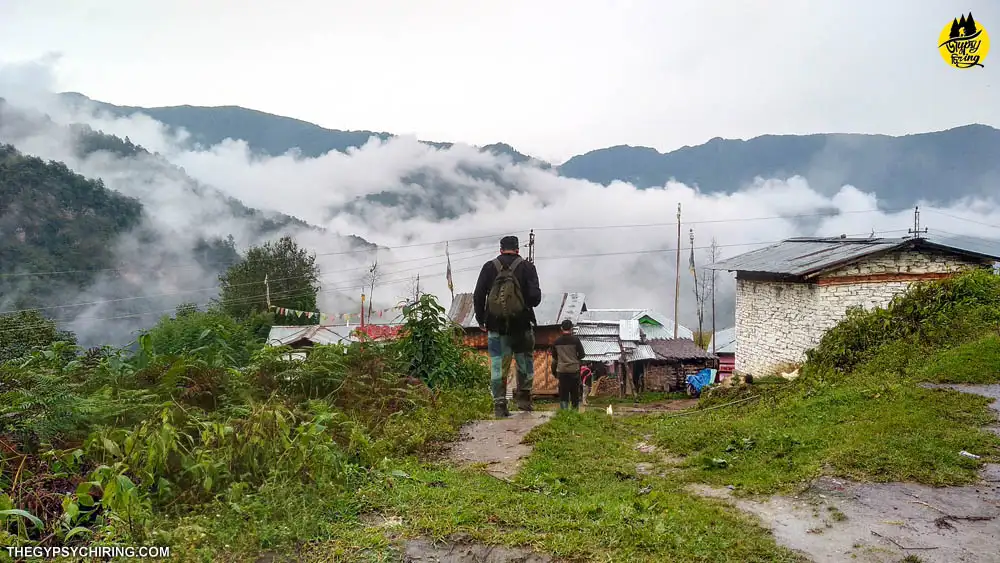
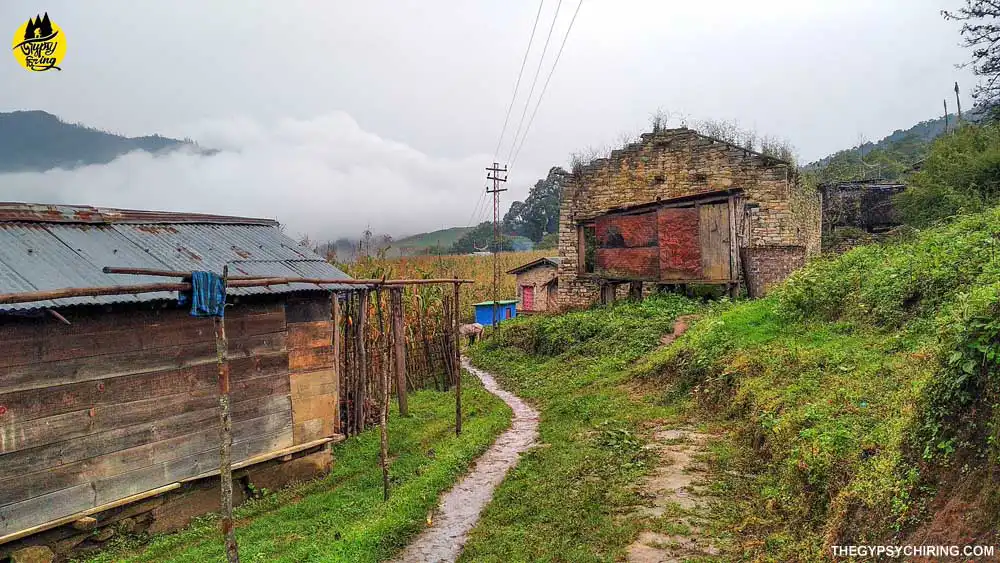
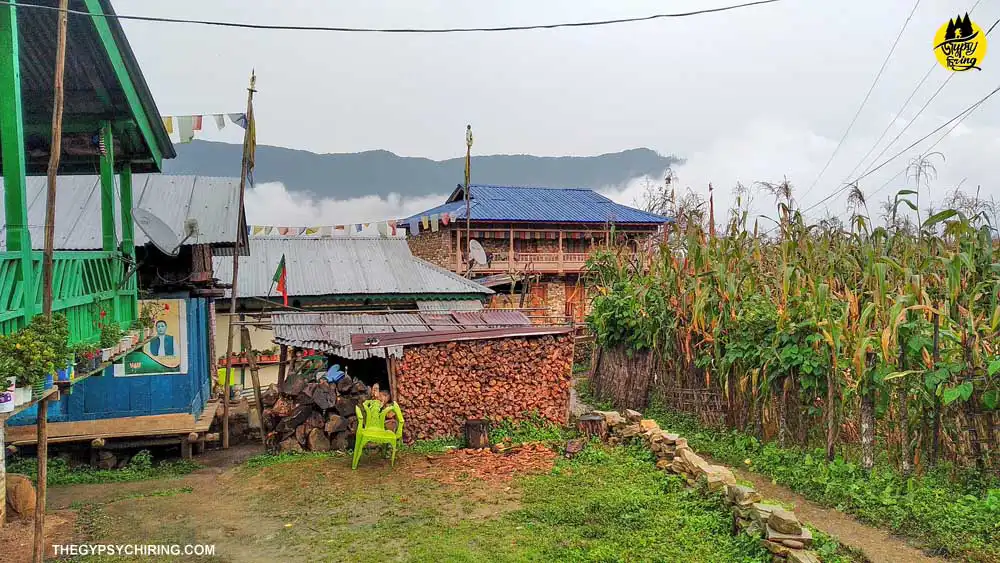
We reached a household whose family members were busy plucking corn and dry frying them.
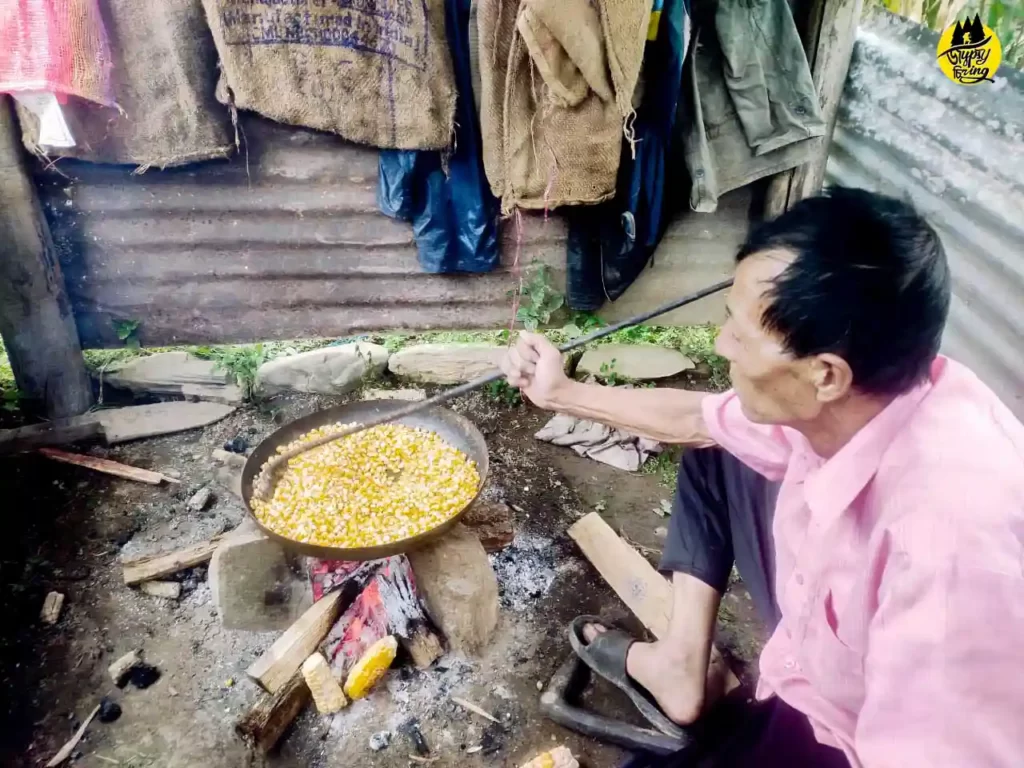
They offered a cup of Aaarah (made of corn) as soon we reached their front year. We spent time talking with them about their life in Pangma and corn cultivation.
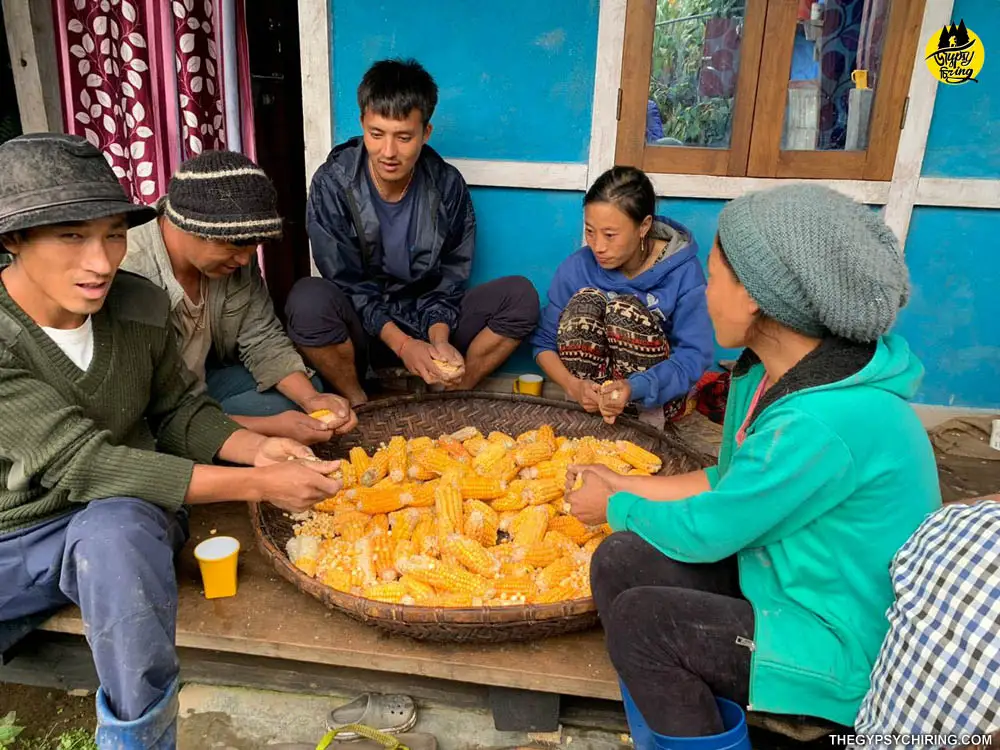
We rested for a while. The evening around the fireplace was amazing. Khandu, our guides and porters and all of us gathered around it.
We would sing local Monpa, Hindi, Assamese and English songs. Each of us would then decipher the meaning of the song to all of us. This experience was more like a cultural exchange.
Monpa Trail Day 5 – Pangma & Thembang (Arunachal Pradesh) to Guwahati, Assam.
As I stretched my arms standing on the verandah that morning, the clouds moved along the ridge of the hills. It was the last day of the trek. I stood by the stream water to brush while enjoying the view of the village and hills.

It was time to bid adieu to this beautiful natural and cultural experience. After sipping a cup of tea, Khandu and his team gifted us a souvenir.
While Ngwang went back to Khalibok via Chander, and Khandu and his team back to Sangti, we began our hike to Thembang Village.
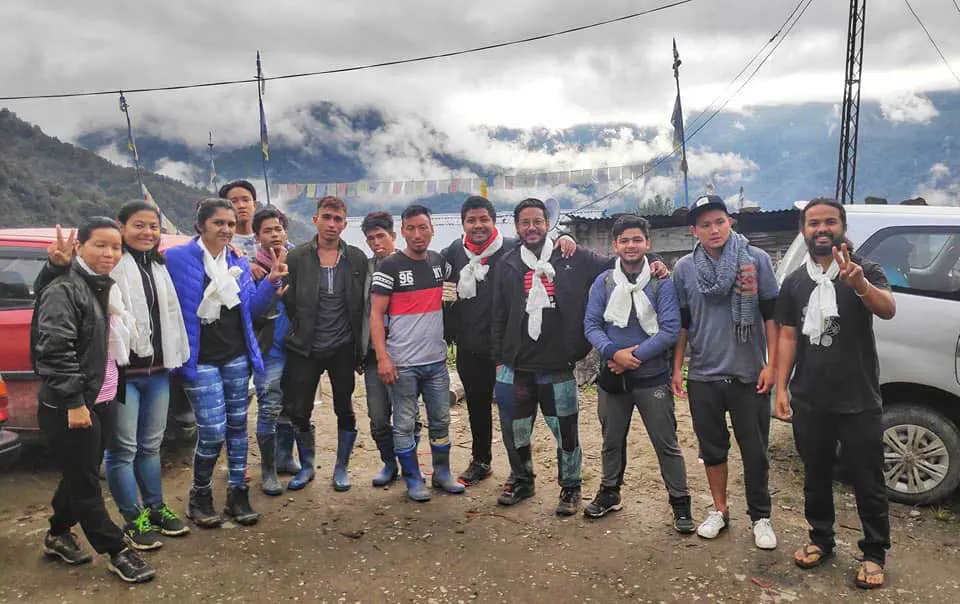
The weather was the brightest that day. Clean roads, green hills, colourful trees, distant meadows and valleys soothed our minds.
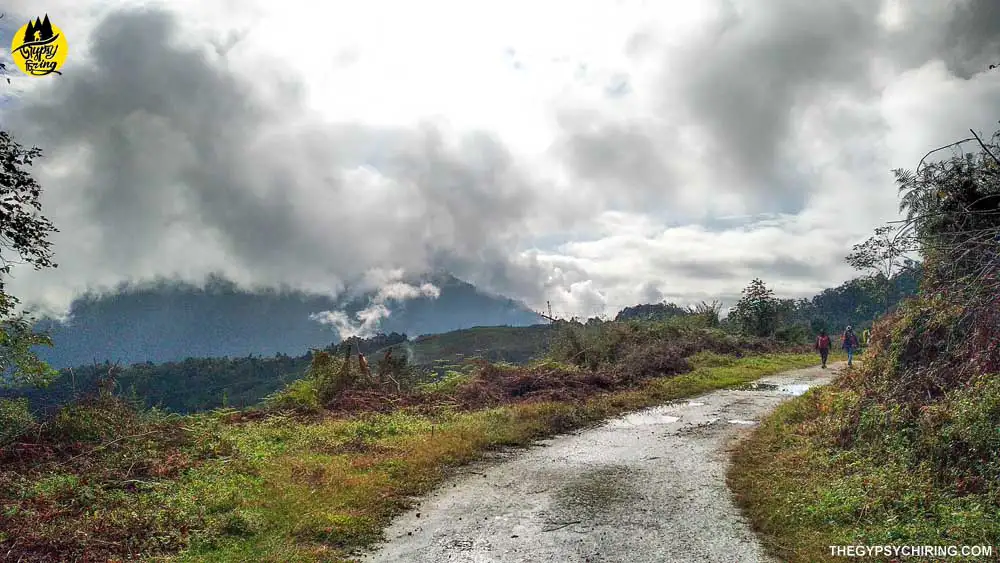
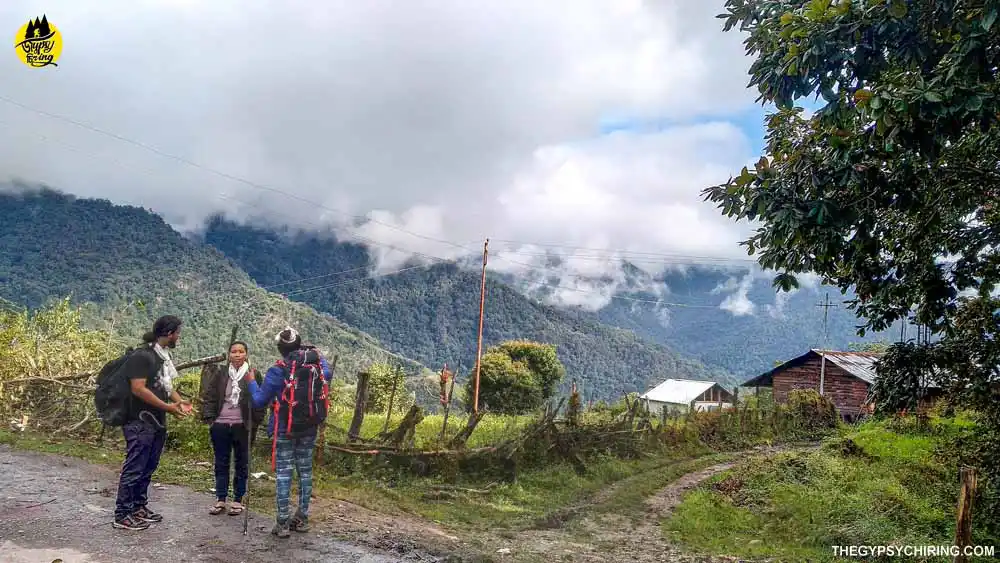
A soothing melody of the flute resonated as we were about to take a turn. An old Monpa man played his heart out on his flute during his solo hike to Pangma. Beautiful right?
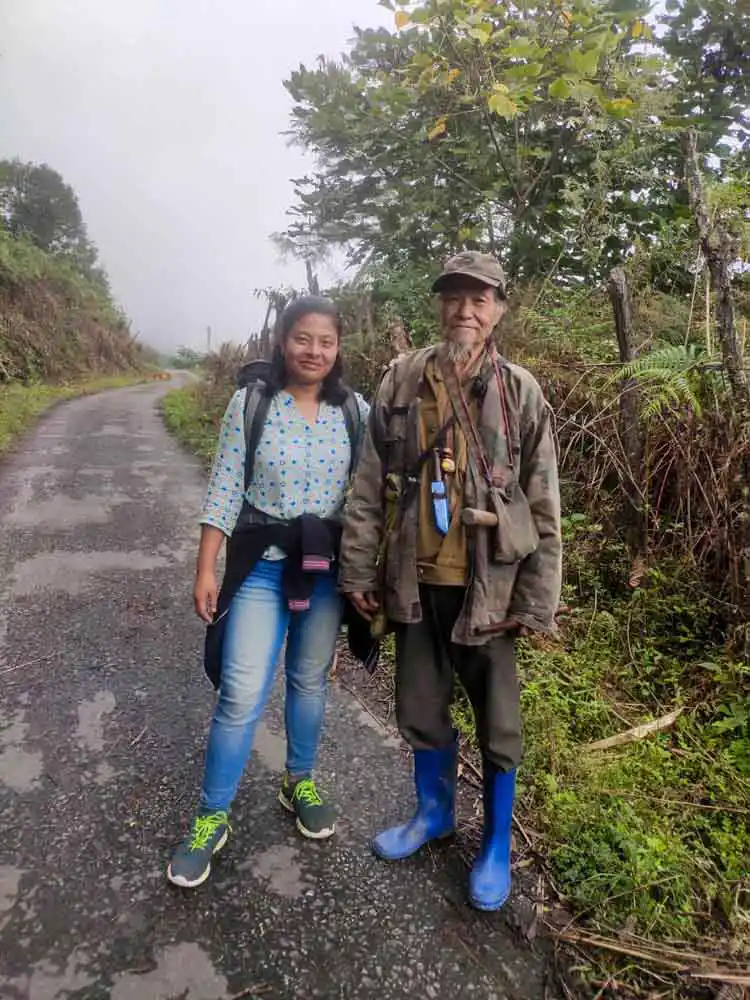
We hiked the trail slowly, stopping at multiple points to enjoy the scenery. We would sit on the concrete structure depicting distance and watch the valley. The view of distant terrace fields covered by a small cloud and a tiny yet aesthetic cottage was a sight to behold.
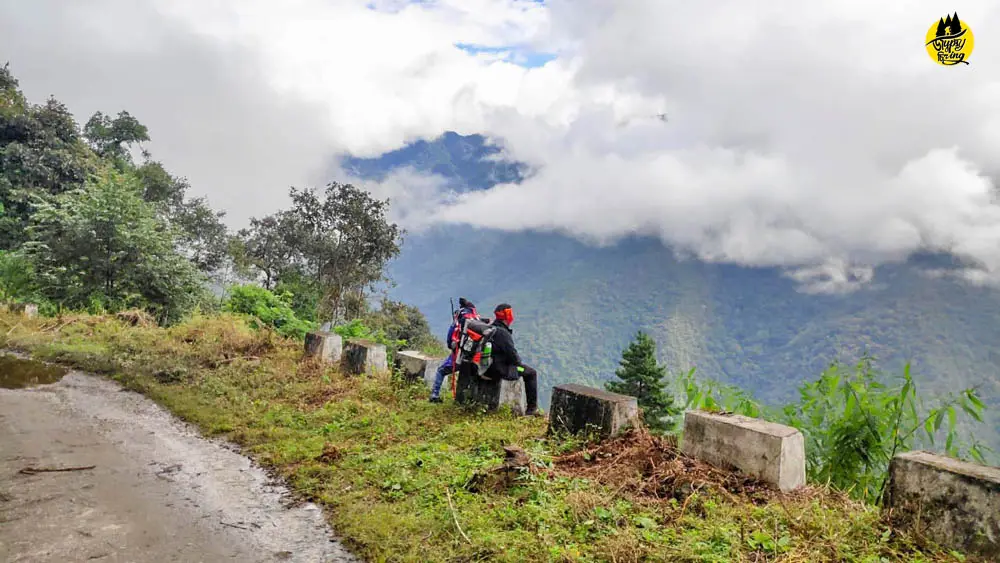
The trek ended when we reached the War Memorial of Indian Soldiers of the 1962 India-China War. The way back via our Innova vehicle was even more scenic. We didn’t get to see its astounding natural beauty on the first day as it was dark.
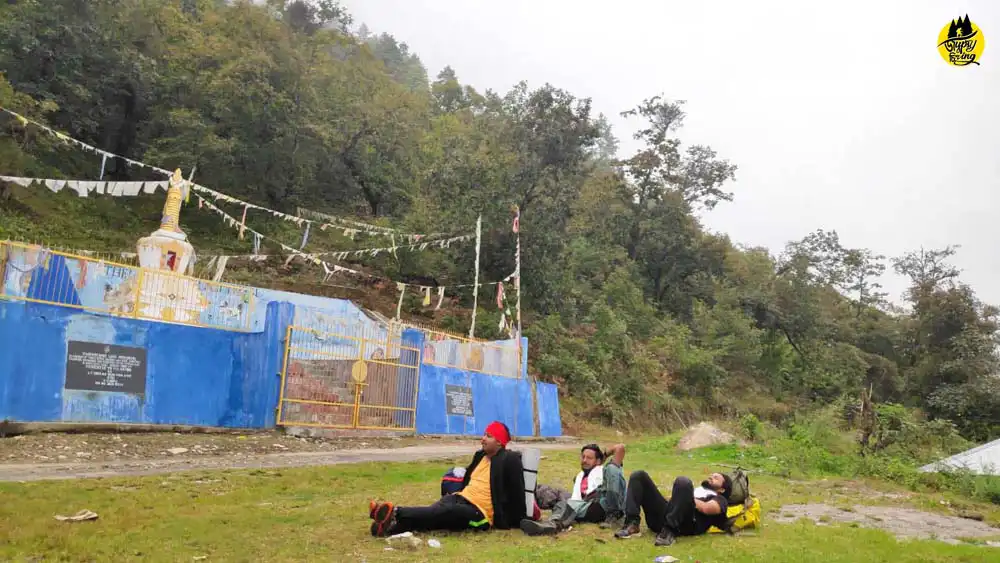
Huge valleys, gushing river waters, the revealing pine trees through the mist/clouds, the agricultural fields on the distant slopes and the songs we sang on our drive back turned out to be the perfect goodbye to our trekking experience.
Things to Carry for Monpa Trail Trek
1. Trekking Pole
A good trekking pole is handy for the steeper sections and slippery parts of the trails.
2. Poncho
Rain or drizzle is imminent in September. A good poncho will be helpful during rain and snowfall. We received rain on the first day of the trek itself. Poncho saved the dilemma of getting wet.
3. Rucksack
A rucksack that suits and balances well on the back helps in walking with more convenience during the treks. I used this rucksack from Amazon during this trek.
Though I used that rucksack during the Monpa Trail Trek, I prefer the TRAWOC Rucksack and the one I brought from Decathlon more. I still use the latter two now.
4. Gumboots or Trekking Shoes
Our guides and porters wore the locally available gumboots which protect you from getting wet, mud and leeches.
Good waterproof trekking shoes are recommended too. I wore the waterproof trekking shoes from Decathlon.
FAQ on Monpa Trail Trek (Answered)
Where is the Sangti Valley location?
The Sangti Valley location is about 13.5 km from Dirang town of West Kameng district in Arunachal Pradesh.
About Sangti Valley Stay
There are several homestays in and around Sangti Valley – Letro Homestay and Dirang Boutique Cottages.
What are some Sangti Valley Homestay suggestions?
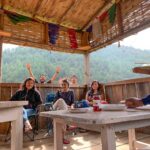
At Sangti Valley, we stayed at the Letro Homestay beside the river. It has luxury tents as well as camping tents for stay. You can pitch your tents too.
Where is Chandar (Chander)?
Chandar or Chander is located in Thembang Circle of West Kameng District of Arunachal Pradesh. The altitude of Chandar (Chander) is 2960 m (9711 ft).
Where does the Monpa Trail trek or Sangti Valley Trek end?
The Monpa trail trek or the Sangti Valley Trek ends in Thembang Village of West Kameng District of Arunachal Pradesh.
What is the best time to do the Monpa Trail Trek?
The best time to do the Monpa Trail trek is after the monsoon months are over. We did the trek during the first week of October. ( Durga Puja Holidays)
How to Reach Sangti Valley?
To reach Sangti Valley first you have to reach Guwahati via road or at LGBI Airport or Guwahati Railway Station.
You can book a shared sumo vehicle which plies to Dirang or Tawang at ASTC bus stand Guwahati. It leaves around 4-6 am. There’s also a bus to Bomdilla around 8 pm
The alternate route is to reach Tezpur from Guwahati either by road, flight or train. You can board sumo from ASTC bust stand Tezpur around 6 am to Dirang.
From Dirang you have to hire a vehicle to reach Sangti Valley which is about 14 km.
Conclusion
The Monpa Trail Trek should be one of Arunachal Pradesh’s most unique treks. It not only allows you to experience its raw natural beauty but also introduces you to its diverse culture.
From stunning sceneries to dancing to Monpa songs, to bonding with the people of Chander and Pangma, I had a fascinating experience.
I would highly suggest everyone book their stay at Letro Homestay and Campsite at Sangti Valley. Khandu Namge, who looks after the homestay is the organiser of the trek.
The morning ambience by the riverside at the campsite is a worthy experience you must have. The trailhead of this trek starts from his Campsite.
As the trek proceeds, the views become more spectacular. A relatively offbeat trek of Arunachal Pradesh, the Monpa Trail Trek ought to be on your list.
If you wish to watch a video of the trek made by Timeless Existence, Click Here.
Have you been to Sangti Valley yet?
Do you wish to travel and explore Arunachal Pradesh? If yes, here’s a book written on Arunachal Pradesh by Jitadiya Narzary of The Travelling Slacker Travel Blog – Immersive Arunachal: A Traveller’s Handbook
Disclosure: This post contains affiliate links to trusted partners.


Hi,
I am keen interested to go for this trek.
Kindly contact me @9968821799.
Please share your contact number too.
Hi Sunil, Thanks for showing your interest in doing the Monpa Trail Trek. You can contact Timeless Existence or Khandu Namgey (of Letro Homestay at Dirang) to go for the trek.
Watching you do what you love brings me such joy! Cheers to more adventurous!
Mitela Zhisa. Thanks for reading the article. Cheers to more adventures!
Every story you write is just a unique experience. I am really impressed with your writing style. Keep it up Bro! I wish someday I can also be a part of your wonderful trekking adventure.
Thank you. Every travel experience has indeed been new and empowering. I am glad that you loved my writing. We can definitely plan for shot hikes. This Monpa Trail Trek is an easy trek too.
Really great article. The trail seems very majestic and the way it has been described makes it more interesting. Hope to visit these places someday.. especially Thembang.
I hope you get to visit Thembang soon. During the trek, we could only pass through it. I am yet to fully explore the village.
Beautifully written, felt like I was there with you too. Arunachal needs the exposure it longs for thank you for sharing your experience to the world.
Thanks. Arunachal Pradesh indeed deserves exposure and most importantly awareness amongst other citizens of India as well as foreign tourists.
Arunachal is on my bucket list and this blog is definitely going to help me a lot when I plan my trip. Thank you.
I am glad to know that. Sangti Valley and Dirang are must-visit destinations of Arunachal Pradesh if you plan to visit the Tawang Circuit. Both these places are offbeat, less crowded and beautiful.
That’s a great article. Looking forward to experiencing this trail. Looks very very untouched and full of traditional experience.
:))
Thank you, Ashish. You would love doing it. It’s a relatively easy trek, but the experience and interaction with the people make it unique and special. The next article would be on the NIMAS experience. Stay tuned!
My first north-east trek & im glad for being part – finishing the 5 day trek with amazing people I met in this journey. Unforgettable and extreme fun trek. Lot of new experience and new friendship.
Good write up
Cheers
The best holidays ever. Meeting you all and then Ngwang Achi and everyone in Arunachal Pradesh was the best thing about the trek.
Thank you, I am glad you could reminisce about those good days. Cheers Machi!